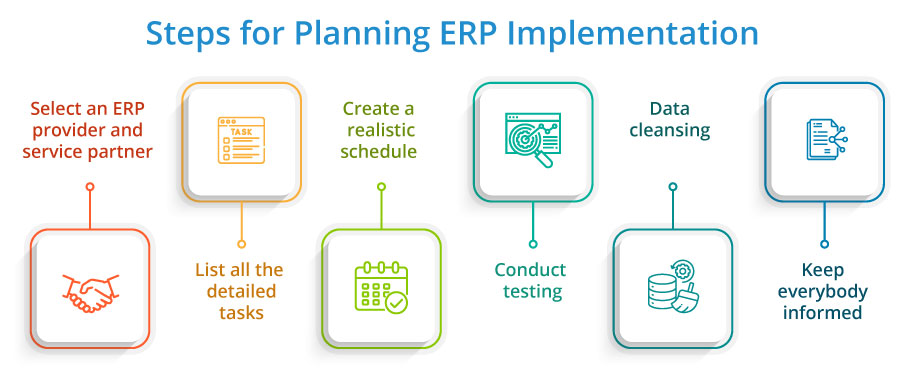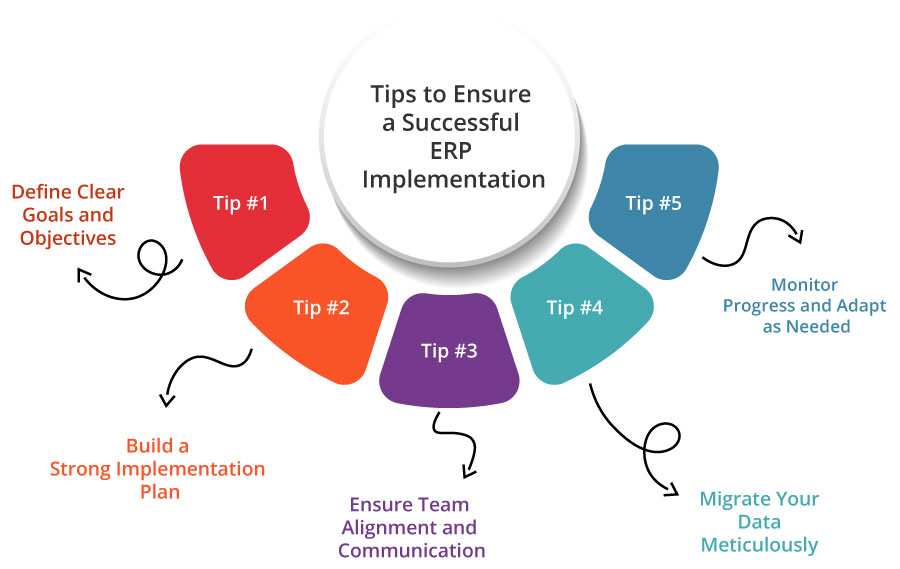Once you have selected ERP software for your organization, it’s time to implement it. We have read and heard about the numerous benefits of ERP for businesses of all sizes. But to actually experience the benefits, ERP software implementation must be successful. In this blog, we have covered the steps of ERP implementation planning, common pitfalls to avoid in the process, stages, and tips for a successful implementation process.
What Is ERP Implementation?
ERP implementation involves installing and configuring ERP software remotely or on-site to improve efficiency and organizational productivity. It includes planning, researching, and selecting a new ERP system, configuring and customizing it according to your business, training the staff, testing specific modules, developing fixes, and going live.
ERP implementation can help an organization with higher data security, increased work productivity, and organized workflows while managing operations in real-time.
Common Challenges During ERP Implementation:
ERP implementation can be challenging because it affects business processes across the entire organization. It is not easy for employees to switch to new business management software, which requires replacing longstanding operations to which they are accustomed. Let us have a quick look at the key ERP implementation challenges:
- Data migration complexities
- Integration issues
- Resistance to change or change management
- Insufficient user training
- Cost overruns
- Select an ERP provider and service partner
Once you have completed the software research and evaluation process, if you don’t have someone in-house experienced with ERP implementation, you may want to select an ERP partner or consultant to help you implement the software. Ensure the ERP partner has a good reputation and is experienced with your industry needs.
An ERP implementation team should include a project manager, functional team members, an implementation partner (if needed), and well-versed representatives of critical business units and product solutions.
- List all the detailed tasks
When you have the list of all tasks that need to be done during the ERP implementation process, make sure deadlines are achievable, and that operations will be streamlined. A few tasks include assessing business needs, building the team, data migration, system configuration, pilot training, and post-implementation support.
The team should divide the tasks into phases to allocate adequate time for integration, customization, implementation, and so on.
- Create a realistic schedule
It is important to define milestones and realistic timelines for an ERP implementation schedule. After listing all the tasks in detail, add the expected work hours for each ERP implementation phase and assign them to the responsible project team member. Your plan and schedule should be based on estimates, with some contingency for unforeseen issues.
- Conduct testing
Conduct a test run before the go-live date. A trial run is done to validate processes and ensure everything is working as it should. This step allows ERP providers to make adjustments for any problem areas.
- Data cleansing
Data cleansing is a time-consuming task, but it is essential to assess data accuracy. Data cleansing involves weeding out any bad data during implementation. Ensure your team understands its importance and is ready to tackle this challenge.
- Keep everybody informed
During the ERP implementation process, the team should communicate progress/updates via email, and have training sessions and meetings to address any challenges.
Tips To Ensure a Successful ERP Implementation
Tip #1: Define Clear Goals and Objectives
Without a clear understanding and defined vision about what you want to achieve from your ERP software, measuring progress becomes challenging, and the business might continue with inefficiencies. Make sure to clearly outline the goals you want to achieve and create a clear roadmap delegating tasks to team members.
Before implementing ERP software, communicate the reasons and strategy and create a clear roadmap delegating tasks to team members. When the objective is unclear to project members and end users, it can create confusion, minimizing the chance of success.
Tip #2: Build a Strong Implementation Plan
A well-structured ERP implementation plan ensures seamless execution and long-term business success. The ERP implementation plan includes assessing systems, defining the goals and scope of the project, cleansing and migrating current business data into the new ERP software, testing it, training staff, and providing ongoing business support and updates.
Risk management and contingency planning can greatly help minimize potential setbacks and ensure business continuity should major challenges occur during the ERP implementation process. It is better to identify potential risks and develop contingency plans beforehand.
Tip #3: Ensure Team Alignment and Communication
Your project team is the driving force behind a successful ERP implementation process. Keeping everyone on the same page is critical to making the deployment process quick and successful. With the aligned team, transitions are smoother, increasing adaption rates while minimizing confusion and errors.
Best practices for keeping stakeholders and teams aligned:
- Define clear roles and responsibilities to avoid miscommunication
- Provide effective training and support with educational sessions
- Encourage feedback from the team to quickly correct any issues
- Establish open communication channels using collaboration tools and shared dashboards
Tip #4: Migrate Your Data Meticulously
Data migration refers to transferring important business data from the current business software to the new ERP system. Data includes customer details, financial records, employee data, inventory data, and more.
Make sure to analyze your business data with your ERP vendor so they can help determine the data quality. It is also important to show your critical business reports to the vendor to help them with the data migration process.
Tip #5: Monitor Progress and Adapt as Needed
Once the implementation process is complete, the project team should ensure continuous monitoring of effectiveness. This helps the organization identify potential bottlenecks and optimize workflows. Regular feedback from users highlights challenges, gaps in the system, and inefficiencies that the project team must address.
Organizations should track KPIs (Key Performance Indicators) that are aligned with the business goals. These KPIs include cost savings and ROI, data accuracy and integrity, system adoption rates, process efficiency, and customer and employee satisfaction.
Common Pitfalls to Avoid in ERP Implementation
If not planned diligently, ERP implementation can be daunting for an organization. To ensure you don’t end up with overtime and an excessive budget, make sure to avoid these mistakes:
- Poor planning and strategy
- Choosing the wrong ERP system
- Inadequate change management
- Insufficient budgeting
- Lack of executive buy-in
- Over-customization within the software
- Insufficient training and user adoption
- Data migration issues
- Integration challenges
- Unrealistic timelines
- Overlooking post-implementation support
Summary
The ERP implementation process requires meticulous planning, clear objectives, and strong project team alignment. A well-executed ERP implementation plan keeps organizations organized, on budget, and primed for maximum efficiency and seamless operations. Whether you are investing in an ERP solution for the first time or migrating from an existing ERP to a new one, make sure you understand your business needs to select and implement the best software solution.
Contact our ERP experts if you are interested in our leading process manufacturing solutions.




